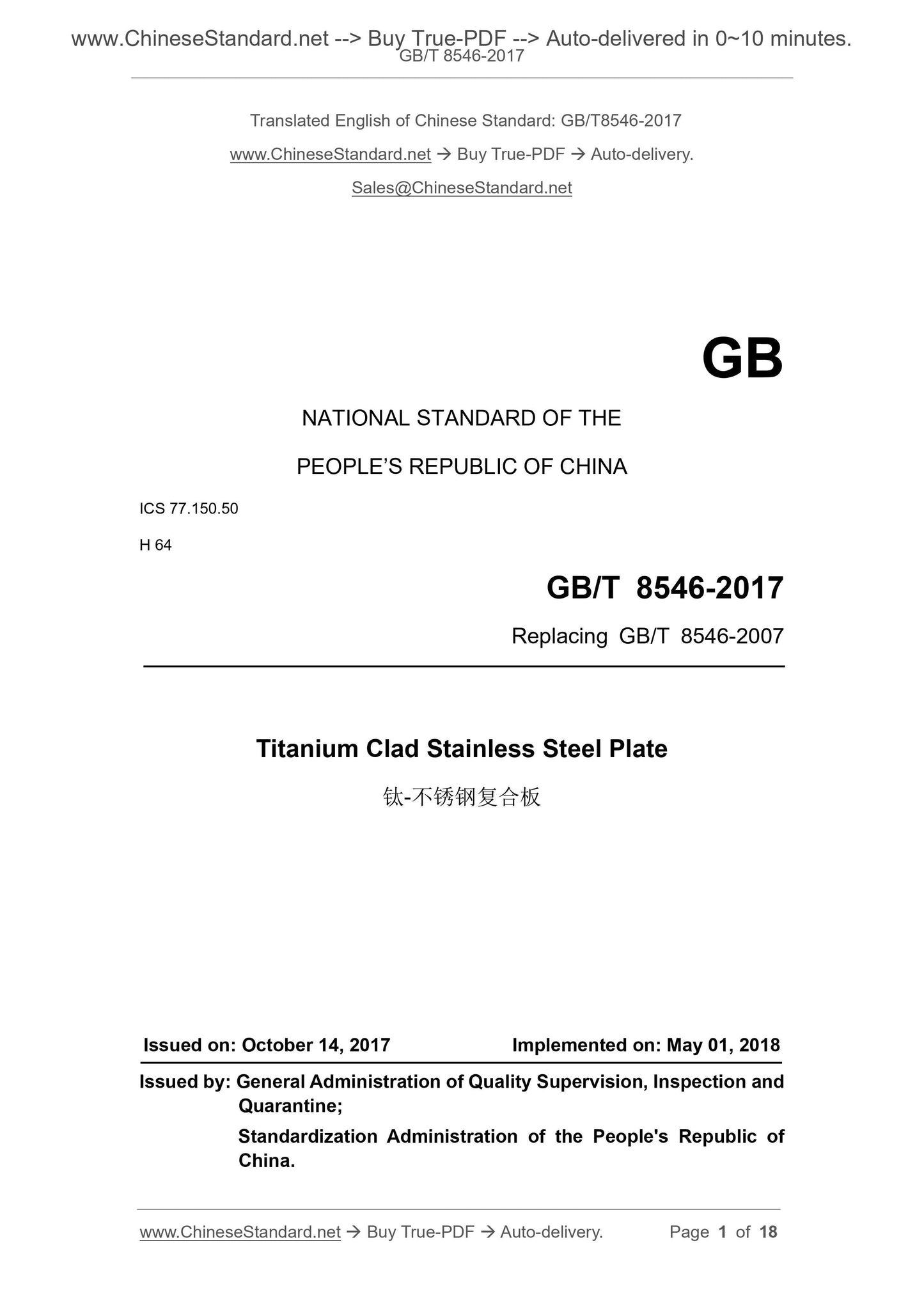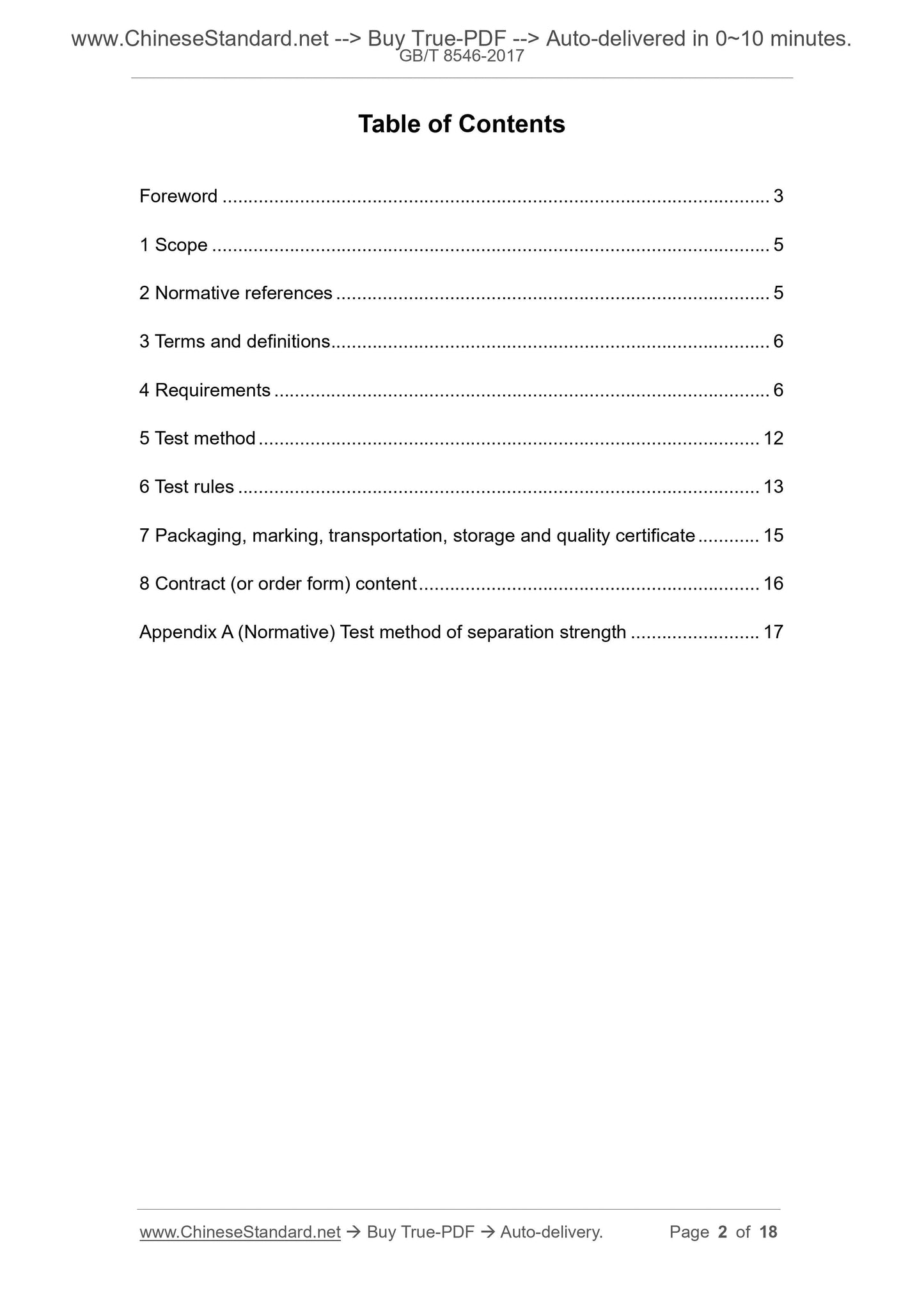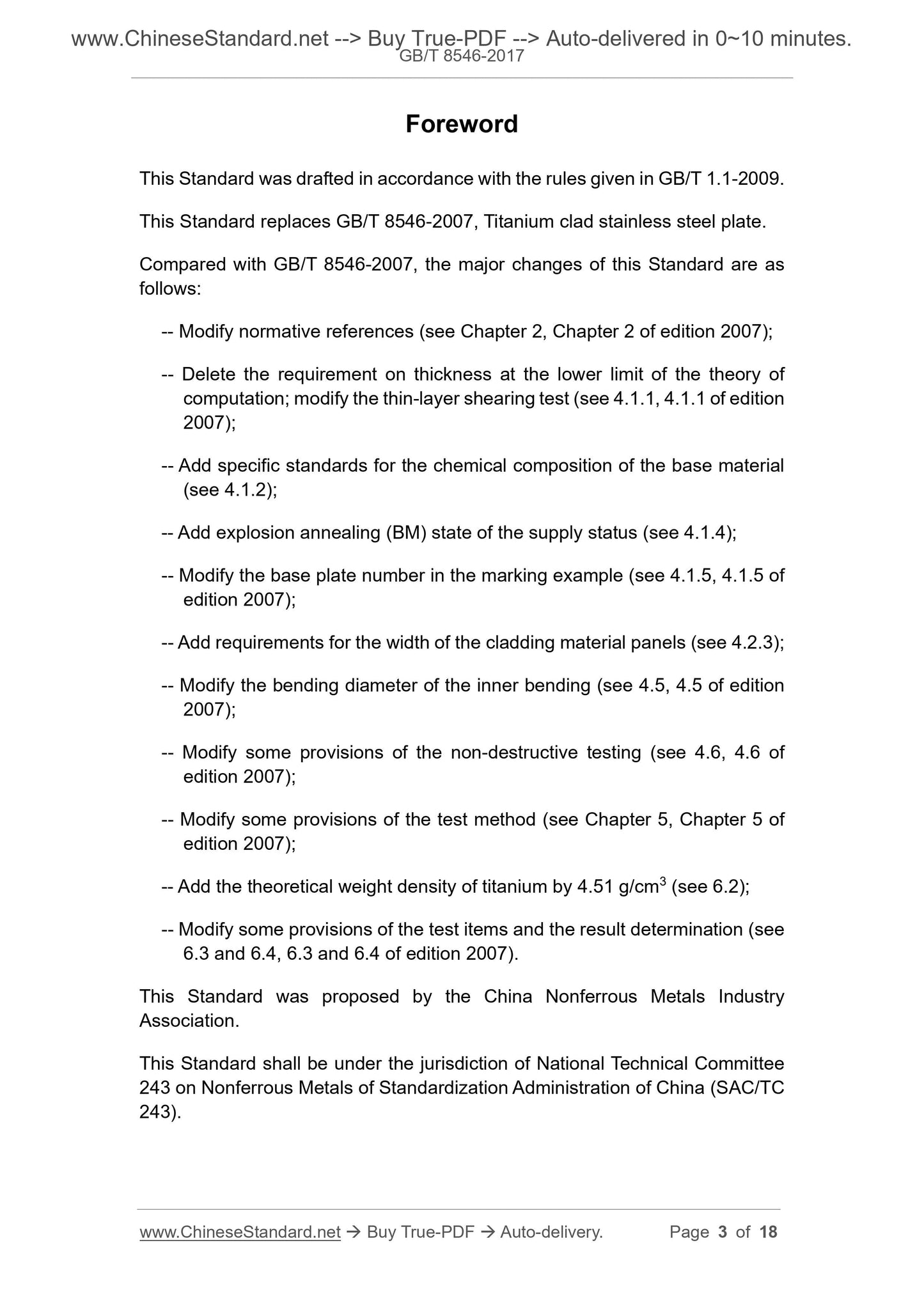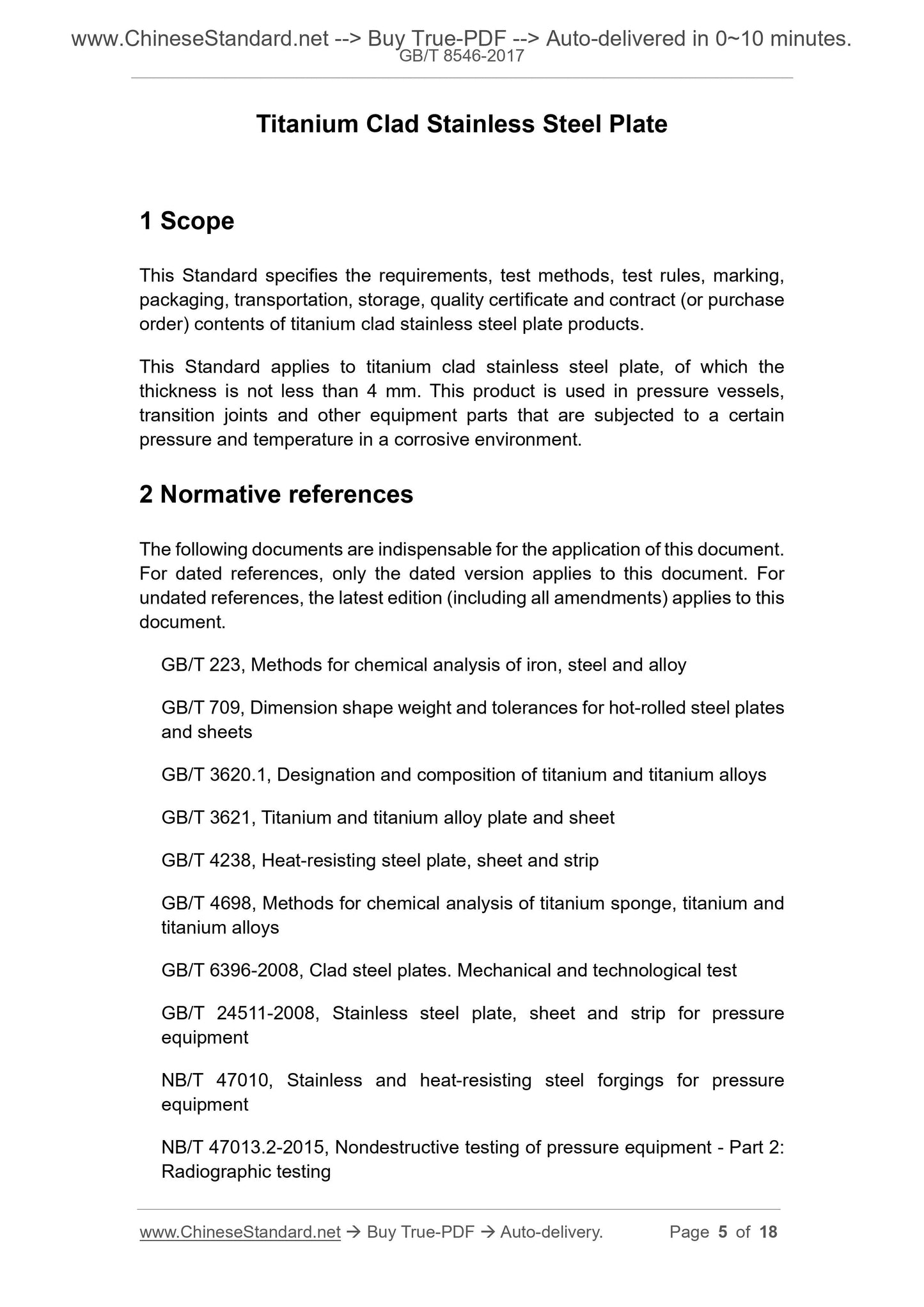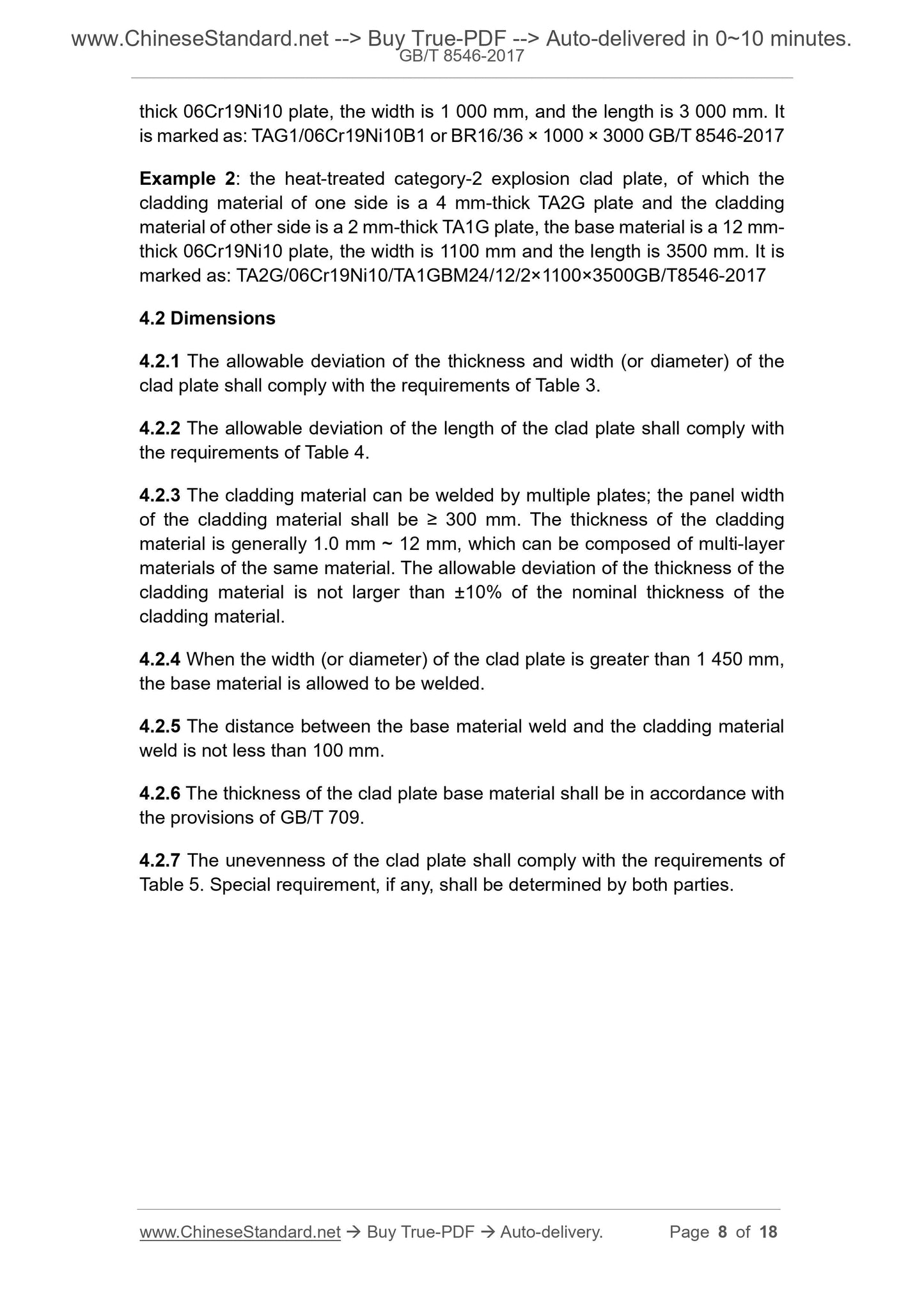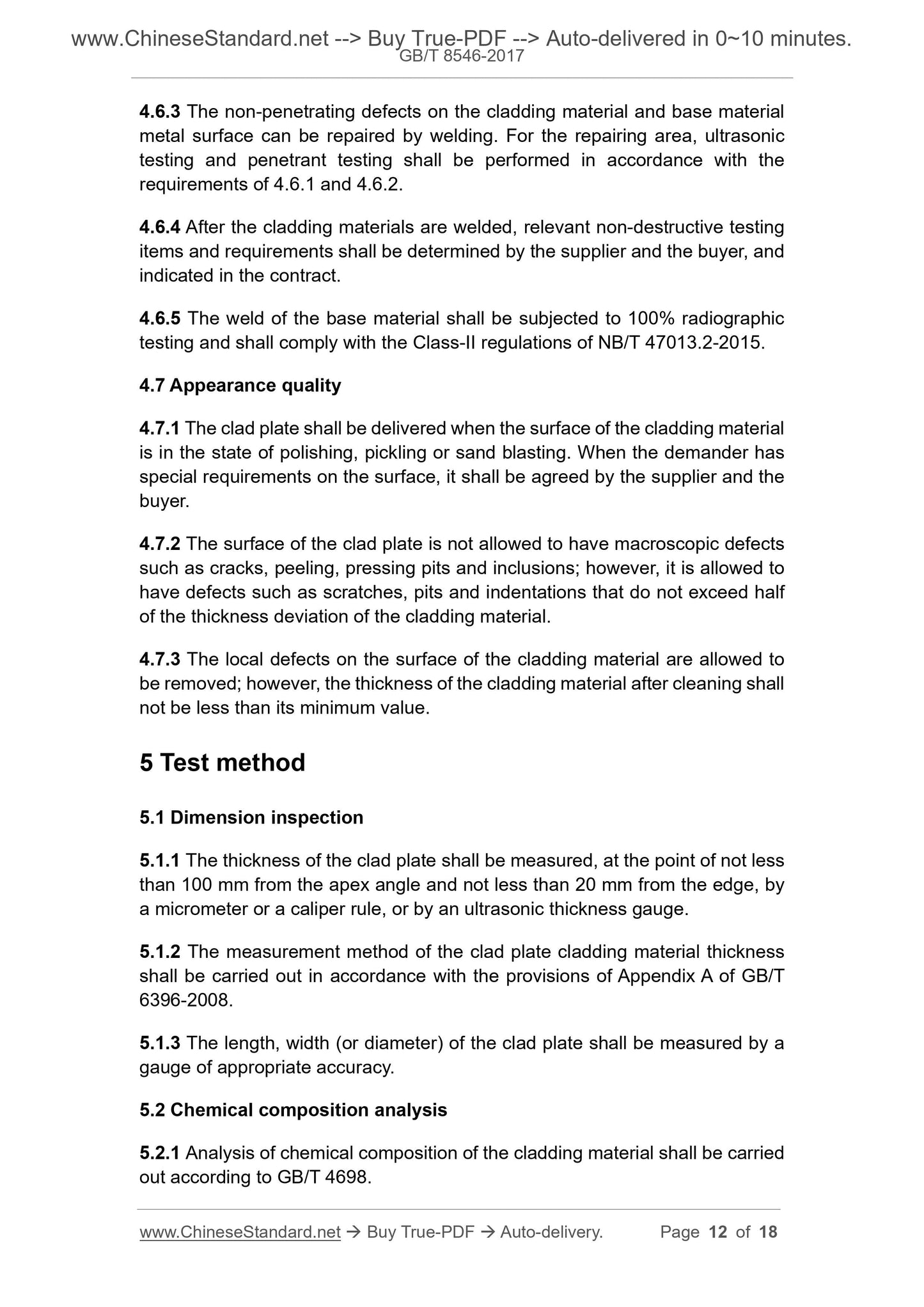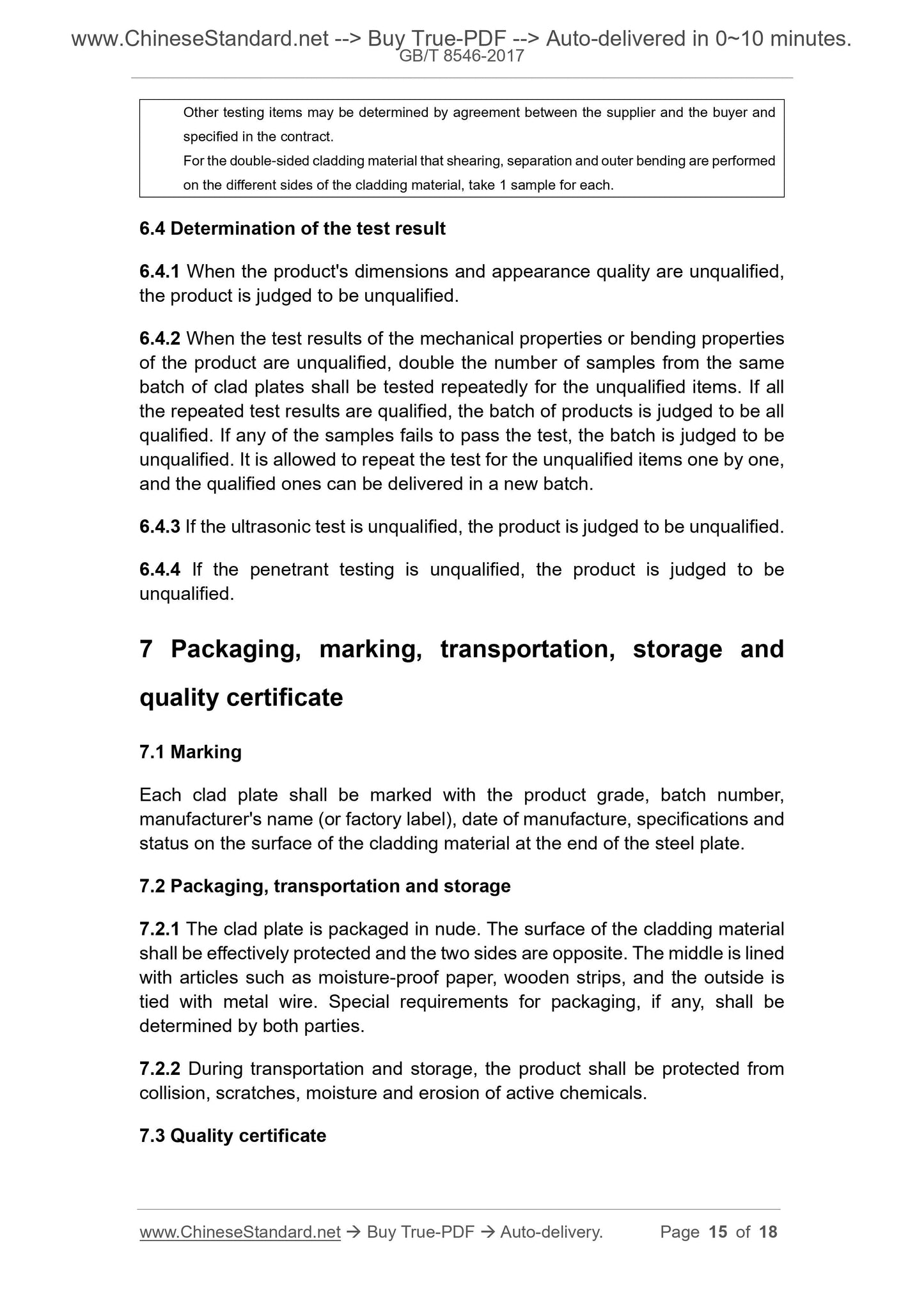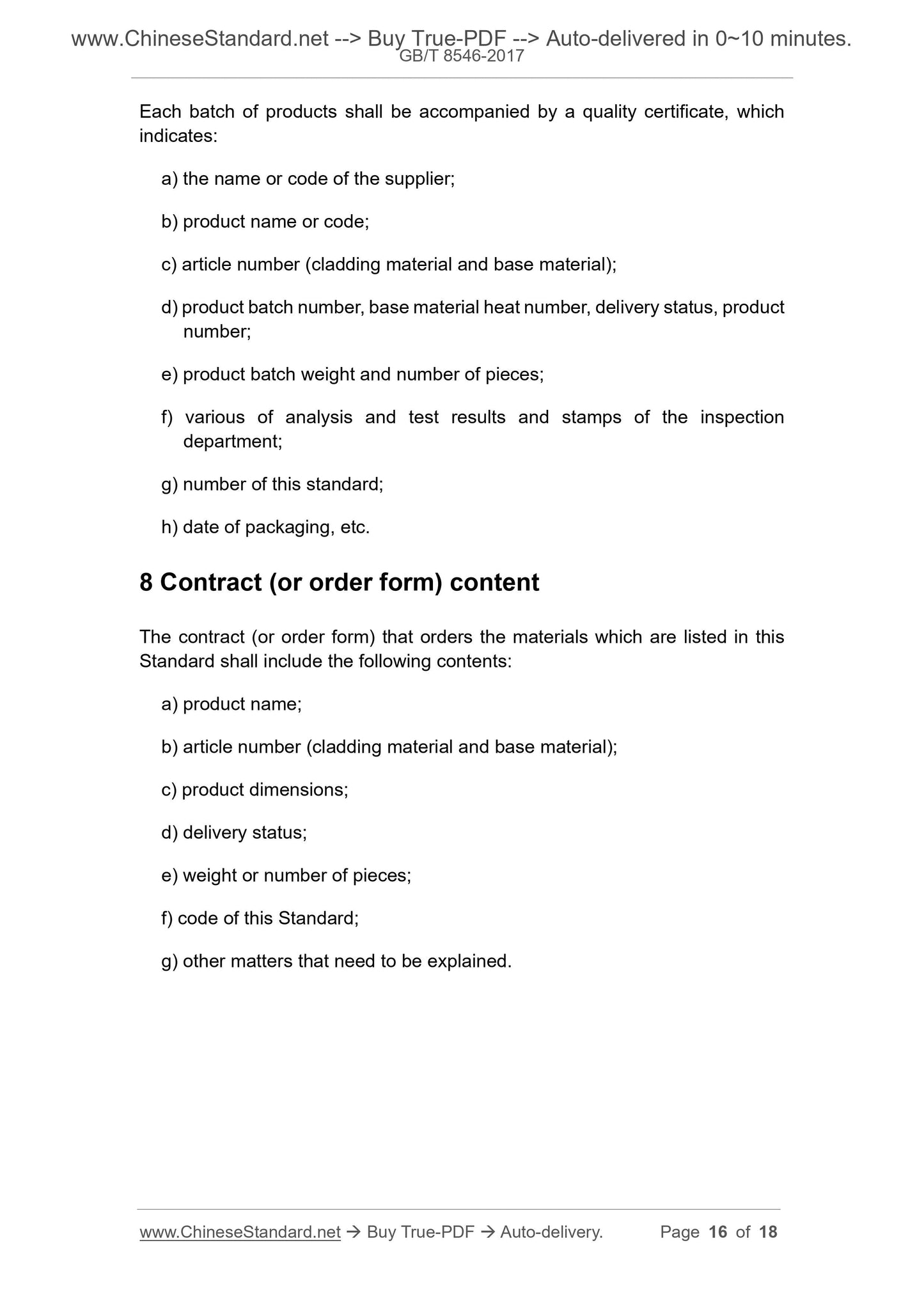1
/
of
8
www.ChineseStandard.us -- Field Test Asia Pte. Ltd.
GB/T 8546-2017 English PDF (GB/T8546-2017)
GB/T 8546-2017 English PDF (GB/T8546-2017)
Regular price
$150.00
Regular price
Sale price
$150.00
Unit price
/
per
Shipping calculated at checkout.
Couldn't load pickup availability
GB/T 8546-2017: Titanium Clad Stainless Steel Plate
Delivery: 9 seconds. Download (& Email) true-PDF + Invoice.
Get Quotation: Click GB/T 8546-2017 (Self-service in 1-minute)
Historical versions (Master-website): GB/T 8546-2017
Preview True-PDF (Reload/Scroll-down if blank)
GB/T 8546-2017
NATIONAL STANDARD OF THE
PEOPLE’S REPUBLIC OF CHINA
ICS 77.150.50
H 64
Replacing GB/T 8546-2007
Titanium Clad Stainless Steel Plate
ISSUED ON: OCTOBER 14, 2017
IMPLEMENTED ON: MAY 01, 2018
Issued by: General Administration of Quality Supervision, Inspection and
Quarantine;
Standardization Administration of the People's Republic of
China.
Table of Contents
Foreword ... 3
1 Scope ... 5
2 Normative references ... 5
3 Terms and definitions ... 6
4 Requirements ... 6
5 Test method ... 12
6 Test rules ... 13
7 Packaging, marking, transportation, storage and quality certificate ... 15
8 Contract (or order form) content ... 16
Appendix A (Normative) Test method of separation strength ... 17
Foreword
This Standard was drafted in accordance with the rules given in GB/T 1.1-2009.
This Standard replaces GB/T 8546-2007, Titanium clad stainless steel plate.
Compared with GB/T 8546-2007, the major changes of this Standard are as
follows:
-- Modify normative references (see Chapter 2, Chapter 2 of edition 2007);
-- Delete the requirement on thickness at the lower limit of the theory of
computation; modify the thin-layer shearing test (see 4.1.1, 4.1.1 of edition
2007);
-- Add specific standards for the chemical composition of the base material
(see 4.1.2);
-- Add explosion annealing (BM) state of the supply status (see 4.1.4);
-- Modify the base plate number in the marking example (see 4.1.5, 4.1.5 of
edition 2007);
-- Add requirements for the width of the cladding material panels (see 4.2.3);
-- Modify the bending diameter of the inner bending (see 4.5, 4.5 of edition
2007);
-- Modify some provisions of the non-destructive testing (see 4.6, 4.6 of
edition 2007);
-- Modify some provisions of the test method (see Chapter 5, Chapter 5 of
edition 2007);
-- Add the theoretical weight density of titanium by 4.51 g/cm3 (see 6.2);
-- Modify some provisions of the test items and the result determination (see
6.3 and 6.4, 6.3 and 6.4 of edition 2007).
This Standard was proposed by the China Nonferrous Metals Industry
Association.
This Standard shall be under the jurisdiction of National Technical Committee
243 on Nonferrous Metals of Standardization Administration of China (SAC/TC
243).
Titanium Clad Stainless Steel Plate
1 Scope
This Standard specifies the requirements, test methods, test rules, marking,
packaging, transportation, storage, quality certificate and contract (or purchase
order) contents of titanium clad stainless steel plate products.
This Standard applies to titanium clad stainless steel plate, of which the
thickness is not less than 4 mm. This product is used in pressure vessels,
transition joints and other equipment parts that are subjected to a certain
pressure and temperature in a corrosive environment.
2 Normative references
The following documents are indispensable for the application of this document.
For dated references, only the dated version applies to this document. For
undated references, the latest edition (including all amendments) applies to this
document.
GB/T 223, Methods for chemical analysis of iron, steel and alloy
GB/T 709, Dimension shape weight and tolerances for hot-rolled steel plates
and sheets
GB/T 3620.1, Designation and composition of titanium and titanium alloys
GB/T 3621, Titanium and titanium alloy plate and sheet
GB/T 4238, Heat-resisting steel plate, sheet and strip
GB/T 4698, Methods for chemical analysis of titanium sponge, titanium and
titanium alloys
GB/T 6396-2008, Clad steel plates. Mechanical and technological test
GB/T 24511-2008, Stainless steel plate, sheet and strip for pressure
equipment
NB/T 47010, Stainless and heat-resisting steel forgings for pressure
equipment
NB/T 47013.2-2015, Nondestructive testing of pressure equipment - Part 2:
Radiographic testing
thick 06Cr19Ni10 plate, the width is 1 000 mm, and the length is 3 000 mm. It
is marked as: TAG1/06Cr19Ni10B1 or BR16/36 × 1000 × 3000 GB/T 8546-2017
Example 2: the heat-treated category-2 explosion clad plate, of which the
cladding material of one side is a 4 mm-thick TA2G plate and the cladding
material of other side is a 2 mm-thick TA1G plate, the base material is a 12 mm-
thick 06Cr19Ni10 plate, the width is 1100 mm and the length is 3500 mm. It is
marked as: TA2G/06Cr19Ni10/TA1GBM24/12/2×1100×3500GB/T8546-2017
4.2 Dimensions
4.2.1 The allowable deviation of the thickness and width (or diameter) of the
clad plate shall comply with the requirements of Table 3.
4.2.2 The allowable deviation of the length of the clad plate shall comply with
the requirements of Table 4.
4.2.3 The cladding material can be welded by multiple plates; the panel width
of the cladding material shall be ≥ 300 mm. The thickness of the cladding
material is generally 1.0 mm ~ 12 mm, which can be composed of multi-layer
materials of the same material. The allowable deviation of the thickness of the
cladding material is not larger than ±10% of the nominal thickness of the
cladding material.
4.2.4 When the width (or diameter) of the clad plate is greater than 1 450 mm,
the base material is allowed to be welded.
4.2.5 The distance between the base material weld and the cladding material
weld is not less than 100 mm.
4.2.6 The thickness of the clad plate base material shall be in accordance with
the provisions of GB/T 709.
4.2.7 The unevenness of the clad plate shall comply with the requirements of
Table 5. Special requirement, if any, shall be determined by both parties.
4.6.3 The non-penetrating defects on the cladding material and base material
metal surface can be repaired by welding. For the repairing area, ultrasonic
testing and penetrant testing shall be performed in accordance with the
requirements of 4.6.1 and 4.6.2.
4.6.4 After the cladding materials are welded, relevant non-destructive testing
items and requirements shall be determined by the supplier and the buyer, and
indicated in the contract.
4.6.5 The weld of the base material shall be subjected to 100% radiographic
testing and shall comply with the Class-II regulations of NB/T 47013.2-2015.
4.7 Appearance quality
4.7.1 The clad plate shall be delivered when the surface of the cladding material
is in the state of polishing, pickling or sand blasting. When the demander has
special requirements on the surface, it shall be agreed by the supplier and the
buyer.
4.7.2 The surface of the clad plate is not allowed to have macroscopic defects
such as cracks, peeling, pressing pits and inclusions; however, it is allowed to
have defects such as scratches, pits and indentations that do not exceed half
of the thickness deviation of the cladding material.
4.7.3 The local defects on the surface of the cladding material are allowed to
be removed; however, the thickness of the cladding material after cleaning shall
not be less than its minimum value.
5 Test method
5.1 Dimension inspection
5.1.1 The thickness of the clad plate shall be measured, at the point of not less
than 100 mm from the apex angle and not less than 20 mm from the edge, by
a micrometer or a caliper rule, or by an ultrasonic thickness gauge.
5.1.2 The measurement method of the clad plate cladding material thickness
shall be carried out in accordance with the provisions of Appendix A of GB/T
6396-2008.
5.1.3 The length, width (or diameter) of the clad plate shall be measured by a
gauge of appropriate accuracy.
5.2 Chemical composition analysis
5.2.1 Analysis of chemical composition of the cladding material shall be carried
out according to GB/T 4698.
Other testing items may be determined by agreement between the supplier and the buyer and
specified in the contract.
For the double-sided cladding material that shearing, separation and outer bending are performed
on the different sides of the cladding material, take 1 sample for each.
6.4 Determination of the test result
6.4.1 When the product's dimensions and appearance quality are unqualified,
the product is judged to be unqualified.
6.4.2 When the test results of the mechanical properties or bending properties
of the product are unqualified, double the number of samples from the same
batch of clad plates shall be tested repeatedly for the unqualified items. If all
the repeated test results are qualified, the batch of products is judged to be all
qualified. If any of the samples fails to pass the test, the batch is judged to be
unqualified. It is allowed to repeat the test for the unqualified items one by one,
and the qualified ones can be delivered in a new batch.
6.4.3 If the ultrasonic test is unqualified, the product is judged to be unqualified.
6.4.4 If the penetrant testing is unqualified, the product is judged to be
unqualified.
7 Packaging, marking, transportation, storage and
quality certificate
7.1 Marking
Each clad plate shall be marked with the product grade, batch number,
manufacturer's name (or factory label), date of manufacture, specifications and
status on the surface of the cladding material at the end of the steel plate.
7.2 Packaging, transportation and storage
7.2.1 The clad plate is packaged in nude. The surface of the cladding material
shall be effectively protected and the two sides are opposite. The middle is lined
with articles such as moisture-proof paper, wooden strips, and the outside is
tied with metal wire. Special requirements for packaging, if any, shall be
determined by both parties.
7.2.2 During transportation and storage, the product shall be protected from
collision, scratches, moisture and erosion of active chemicals.
7.3 Quality certificate
Each batch of products shall be accompanied by a quality certificate, which
indicates:
a) the name or code of the supplier;
b) product name or code;
c) article number (cladding material and base material);
d) product batch number, base material heat number, delivery status, product
number;
e) product batch weight and number of pieces;
f) various of analysis and test results and stamps of the inspection
department;
g) number of this standard;
h) date of packaging, etc.
8 Contract (or order form) content
The contract (or order form) that orders the materials which are listed in this
Standard shall include the following contents:
a) product name;
b) article number (cladding material and base material);
c) product dimensions;
d) delivery status;
e) weight or number of pieces;
f) code of this Standard;
g) other matters that need to be explained.
GB/T 8546-2017
NATIONAL STANDARD OF THE
PEOPLE’S REPUBLIC OF CHINA
ICS 77.150.50
H 64
Replacing GB/T 8546-2007
Titanium Clad Stainless Steel Plate
ISSUED ON: OCTOBER 14, 2017
IMPLEMENTED ON: MAY 01, 2018
Issued by: General Administration of Quality Supervision, Inspection and
Quarantine;
Standardization Administration of the People's Republic of
China.
Table of Contents
Foreword ... 3
1 Scope ... 5
2 Normative references ... 5
3 Terms and definitions ... 6
4 Requirements ... 6
5 Test method ... 12
6 Test rules ... 13
7 Packaging, marking, transportation, storage and quality certificate ... 15
8 Contract (or order form) content ... 16
Appendix A (Normative) Test method of separation strength ... 17
Foreword
This Standard was drafted in accordance with the rules given in GB/T 1.1-2009.
This Standard replaces GB/T 8546-2007, Titanium clad stainless steel plate.
Compared with GB/T 8546-2007, the major changes of this Standard are as
follows:
-- Modify normative references (see Chapter 2, Chapter 2 of edition 2007);
-- Delete the requirement on thickness at the lower limit of the theory of
computation; modify the thin-layer shearing test (see 4.1.1, 4.1.1 of edition
2007);
-- Add specific standards for the chemical composition of the base material
(see 4.1.2);
-- Add explosion annealing (BM) state of the supply status (see 4.1.4);
-- Modify the base plate number in the marking example (see 4.1.5, 4.1.5 of
edition 2007);
-- Add requirements for the width of the cladding material panels (see 4.2.3);
-- Modify the bending diameter of the inner bending (see 4.5, 4.5 of edition
2007);
-- Modify some provisions of the non-destructive testing (see 4.6, 4.6 of
edition 2007);
-- Modify some provisions of the test method (see Chapter 5, Chapter 5 of
edition 2007);
-- Add the theoretical weight density of titanium by 4.51 g/cm3 (see 6.2);
-- Modify some provisions of the test items and the result determination (see
6.3 and 6.4, 6.3 and 6.4 of edition 2007).
This Standard was proposed by the China Nonferrous Metals Industry
Association.
This Standard shall be under the jurisdiction of National Technical Committee
243 on Nonferrous Metals of Standardization Administration of China (SAC/TC
243).
Titanium Clad Stainless Steel Plate
1 Scope
This Standard specifies the requirements, test methods, test rules, marking,
packaging, transportation, storage, quality certificate and contract (or purchase
order) contents of titanium clad stainless steel plate products.
This Standard applies to titanium clad stainless steel plate, of which the
thickness is not less than 4 mm. This product is used in pressure vessels,
transition joints and other equipment parts that are subjected to a certain
pressure and temperature in a corrosive environment.
2 Normative references
The following documents are indispensable for the application of this document.
For dated references, only the dated version applies to this document. For
undated references, the latest edition (including all amendments) applies to this
document.
GB/T 223, Methods for chemical analysis of iron, steel and alloy
GB/T 709, Dimension shape weight and tolerances for hot-rolled steel plates
and sheets
GB/T 3620.1, Designation and composition of titanium and titanium alloys
GB/T 3621, Titanium and titanium ...
Delivery: 9 seconds. Download (& Email) true-PDF + Invoice.
Get Quotation: Click GB/T 8546-2017 (Self-service in 1-minute)
Historical versions (Master-website): GB/T 8546-2017
Preview True-PDF (Reload/Scroll-down if blank)
GB/T 8546-2017
NATIONAL STANDARD OF THE
PEOPLE’S REPUBLIC OF CHINA
ICS 77.150.50
H 64
Replacing GB/T 8546-2007
Titanium Clad Stainless Steel Plate
ISSUED ON: OCTOBER 14, 2017
IMPLEMENTED ON: MAY 01, 2018
Issued by: General Administration of Quality Supervision, Inspection and
Quarantine;
Standardization Administration of the People's Republic of
China.
Table of Contents
Foreword ... 3
1 Scope ... 5
2 Normative references ... 5
3 Terms and definitions ... 6
4 Requirements ... 6
5 Test method ... 12
6 Test rules ... 13
7 Packaging, marking, transportation, storage and quality certificate ... 15
8 Contract (or order form) content ... 16
Appendix A (Normative) Test method of separation strength ... 17
Foreword
This Standard was drafted in accordance with the rules given in GB/T 1.1-2009.
This Standard replaces GB/T 8546-2007, Titanium clad stainless steel plate.
Compared with GB/T 8546-2007, the major changes of this Standard are as
follows:
-- Modify normative references (see Chapter 2, Chapter 2 of edition 2007);
-- Delete the requirement on thickness at the lower limit of the theory of
computation; modify the thin-layer shearing test (see 4.1.1, 4.1.1 of edition
2007);
-- Add specific standards for the chemical composition of the base material
(see 4.1.2);
-- Add explosion annealing (BM) state of the supply status (see 4.1.4);
-- Modify the base plate number in the marking example (see 4.1.5, 4.1.5 of
edition 2007);
-- Add requirements for the width of the cladding material panels (see 4.2.3);
-- Modify the bending diameter of the inner bending (see 4.5, 4.5 of edition
2007);
-- Modify some provisions of the non-destructive testing (see 4.6, 4.6 of
edition 2007);
-- Modify some provisions of the test method (see Chapter 5, Chapter 5 of
edition 2007);
-- Add the theoretical weight density of titanium by 4.51 g/cm3 (see 6.2);
-- Modify some provisions of the test items and the result determination (see
6.3 and 6.4, 6.3 and 6.4 of edition 2007).
This Standard was proposed by the China Nonferrous Metals Industry
Association.
This Standard shall be under the jurisdiction of National Technical Committee
243 on Nonferrous Metals of Standardization Administration of China (SAC/TC
243).
Titanium Clad Stainless Steel Plate
1 Scope
This Standard specifies the requirements, test methods, test rules, marking,
packaging, transportation, storage, quality certificate and contract (or purchase
order) contents of titanium clad stainless steel plate products.
This Standard applies to titanium clad stainless steel plate, of which the
thickness is not less than 4 mm. This product is used in pressure vessels,
transition joints and other equipment parts that are subjected to a certain
pressure and temperature in a corrosive environment.
2 Normative references
The following documents are indispensable for the application of this document.
For dated references, only the dated version applies to this document. For
undated references, the latest edition (including all amendments) applies to this
document.
GB/T 223, Methods for chemical analysis of iron, steel and alloy
GB/T 709, Dimension shape weight and tolerances for hot-rolled steel plates
and sheets
GB/T 3620.1, Designation and composition of titanium and titanium alloys
GB/T 3621, Titanium and titanium alloy plate and sheet
GB/T 4238, Heat-resisting steel plate, sheet and strip
GB/T 4698, Methods for chemical analysis of titanium sponge, titanium and
titanium alloys
GB/T 6396-2008, Clad steel plates. Mechanical and technological test
GB/T 24511-2008, Stainless steel plate, sheet and strip for pressure
equipment
NB/T 47010, Stainless and heat-resisting steel forgings for pressure
equipment
NB/T 47013.2-2015, Nondestructive testing of pressure equipment - Part 2:
Radiographic testing
thick 06Cr19Ni10 plate, the width is 1 000 mm, and the length is 3 000 mm. It
is marked as: TAG1/06Cr19Ni10B1 or BR16/36 × 1000 × 3000 GB/T 8546-2017
Example 2: the heat-treated category-2 explosion clad plate, of which the
cladding material of one side is a 4 mm-thick TA2G plate and the cladding
material of other side is a 2 mm-thick TA1G plate, the base material is a 12 mm-
thick 06Cr19Ni10 plate, the width is 1100 mm and the length is 3500 mm. It is
marked as: TA2G/06Cr19Ni10/TA1GBM24/12/2×1100×3500GB/T8546-2017
4.2 Dimensions
4.2.1 The allowable deviation of the thickness and width (or diameter) of the
clad plate shall comply with the requirements of Table 3.
4.2.2 The allowable deviation of the length of the clad plate shall comply with
the requirements of Table 4.
4.2.3 The cladding material can be welded by multiple plates; the panel width
of the cladding material shall be ≥ 300 mm. The thickness of the cladding
material is generally 1.0 mm ~ 12 mm, which can be composed of multi-layer
materials of the same material. The allowable deviation of the thickness of the
cladding material is not larger than ±10% of the nominal thickness of the
cladding material.
4.2.4 When the width (or diameter) of the clad plate is greater than 1 450 mm,
the base material is allowed to be welded.
4.2.5 The distance between the base material weld and the cladding material
weld is not less than 100 mm.
4.2.6 The thickness of the clad plate base material shall be in accordance with
the provisions of GB/T 709.
4.2.7 The unevenness of the clad plate shall comply with the requirements of
Table 5. Special requirement, if any, shall be determined by both parties.
4.6.3 The non-penetrating defects on the cladding material and base material
metal surface can be repaired by welding. For the repairing area, ultrasonic
testing and penetrant testing shall be performed in accordance with the
requirements of 4.6.1 and 4.6.2.
4.6.4 After the cladding materials are welded, relevant non-destructive testing
items and requirements shall be determined by the supplier and the buyer, and
indicated in the contract.
4.6.5 The weld of the base material shall be subjected to 100% radiographic
testing and shall comply with the Class-II regulations of NB/T 47013.2-2015.
4.7 Appearance quality
4.7.1 The clad plate shall be delivered when the surface of the cladding material
is in the state of polishing, pickling or sand blasting. When the demander has
special requirements on the surface, it shall be agreed by the supplier and the
buyer.
4.7.2 The surface of the clad plate is not allowed to have macroscopic defects
such as cracks, peeling, pressing pits and inclusions; however, it is allowed to
have defects such as scratches, pits and indentations that do not exceed half
of the thickness deviation of the cladding material.
4.7.3 The local defects on the surface of the cladding material are allowed to
be removed; however, the thickness of the cladding material after cleaning shall
not be less than its minimum value.
5 Test method
5.1 Dimension inspection
5.1.1 The thickness of the clad plate shall be measured, at the point of not less
than 100 mm from the apex angle and not less than 20 mm from the edge, by
a micrometer or a caliper rule, or by an ultrasonic thickness gauge.
5.1.2 The measurement method of the clad plate cladding material thickness
shall be carried out in accordance with the provisions of Appendix A of GB/T
6396-2008.
5.1.3 The length, width (or diameter) of the clad plate shall be measured by a
gauge of appropriate accuracy.
5.2 Chemical composition analysis
5.2.1 Analysis of chemical composition of the cladding material shall be carried
out according to GB/T 4698.
Other testing items may be determined by agreement between the supplier and the buyer and
specified in the contract.
For the double-sided cladding material that shearing, separation and outer bending are performed
on the different sides of the cladding material, take 1 sample for each.
6.4 Determination of the test result
6.4.1 When the product's dimensions and appearance quality are unqualified,
the product is judged to be unqualified.
6.4.2 When the test results of the mechanical properties or bending properties
of the product are unqualified, double the number of samples from the same
batch of clad plates shall be tested repeatedly for the unqualified items. If all
the repeated test results are qualified, the batch of products is judged to be all
qualified. If any of the samples fails to pass the test, the batch is judged to be
unqualified. It is allowed to repeat the test for the unqualified items one by one,
and the qualified ones can be delivered in a new batch.
6.4.3 If the ultrasonic test is unqualified, the product is judged to be unqualified.
6.4.4 If the penetrant testing is unqualified, the product is judged to be
unqualified.
7 Packaging, marking, transportation, storage and
quality certificate
7.1 Marking
Each clad plate shall be marked with the product grade, batch number,
manufacturer's name (or factory label), date of manufacture, specifications and
status on the surface of the cladding material at the end of the steel plate.
7.2 Packaging, transportation and storage
7.2.1 The clad plate is packaged in nude. The surface of the cladding material
shall be effectively protected and the two sides are opposite. The middle is lined
with articles such as moisture-proof paper, wooden strips, and the outside is
tied with metal wire. Special requirements for packaging, if any, shall be
determined by both parties.
7.2.2 During transportation and storage, the product shall be protected from
collision, scratches, moisture and erosion of active chemicals.
7.3 Quality certificate
Each batch of products shall be accompanied by a quality certificate, which
indicates:
a) the name or code of the supplier;
b) product name or code;
c) article number (cladding material and base material);
d) product batch number, base material heat number, delivery status, product
number;
e) product batch weight and number of pieces;
f) various of analysis and test results and stamps of the inspection
department;
g) number of this standard;
h) date of packaging, etc.
8 Contract (or order form) content
The contract (or order form) that orders the materials which are listed in this
Standard shall include the following contents:
a) product name;
b) article number (cladding material and base material);
c) product dimensions;
d) delivery status;
e) weight or number of pieces;
f) code of this Standard;
g) other matters that need to be explained.
GB/T 8546-2017
NATIONAL STANDARD OF THE
PEOPLE’S REPUBLIC OF CHINA
ICS 77.150.50
H 64
Replacing GB/T 8546-2007
Titanium Clad Stainless Steel Plate
ISSUED ON: OCTOBER 14, 2017
IMPLEMENTED ON: MAY 01, 2018
Issued by: General Administration of Quality Supervision, Inspection and
Quarantine;
Standardization Administration of the People's Republic of
China.
Table of Contents
Foreword ... 3
1 Scope ... 5
2 Normative references ... 5
3 Terms and definitions ... 6
4 Requirements ... 6
5 Test method ... 12
6 Test rules ... 13
7 Packaging, marking, transportation, storage and quality certificate ... 15
8 Contract (or order form) content ... 16
Appendix A (Normative) Test method of separation strength ... 17
Foreword
This Standard was drafted in accordance with the rules given in GB/T 1.1-2009.
This Standard replaces GB/T 8546-2007, Titanium clad stainless steel plate.
Compared with GB/T 8546-2007, the major changes of this Standard are as
follows:
-- Modify normative references (see Chapter 2, Chapter 2 of edition 2007);
-- Delete the requirement on thickness at the lower limit of the theory of
computation; modify the thin-layer shearing test (see 4.1.1, 4.1.1 of edition
2007);
-- Add specific standards for the chemical composition of the base material
(see 4.1.2);
-- Add explosion annealing (BM) state of the supply status (see 4.1.4);
-- Modify the base plate number in the marking example (see 4.1.5, 4.1.5 of
edition 2007);
-- Add requirements for the width of the cladding material panels (see 4.2.3);
-- Modify the bending diameter of the inner bending (see 4.5, 4.5 of edition
2007);
-- Modify some provisions of the non-destructive testing (see 4.6, 4.6 of
edition 2007);
-- Modify some provisions of the test method (see Chapter 5, Chapter 5 of
edition 2007);
-- Add the theoretical weight density of titanium by 4.51 g/cm3 (see 6.2);
-- Modify some provisions of the test items and the result determination (see
6.3 and 6.4, 6.3 and 6.4 of edition 2007).
This Standard was proposed by the China Nonferrous Metals Industry
Association.
This Standard shall be under the jurisdiction of National Technical Committee
243 on Nonferrous Metals of Standardization Administration of China (SAC/TC
243).
Titanium Clad Stainless Steel Plate
1 Scope
This Standard specifies the requirements, test methods, test rules, marking,
packaging, transportation, storage, quality certificate and contract (or purchase
order) contents of titanium clad stainless steel plate products.
This Standard applies to titanium clad stainless steel plate, of which the
thickness is not less than 4 mm. This product is used in pressure vessels,
transition joints and other equipment parts that are subjected to a certain
pressure and temperature in a corrosive environment.
2 Normative references
The following documents are indispensable for the application of this document.
For dated references, only the dated version applies to this document. For
undated references, the latest edition (including all amendments) applies to this
document.
GB/T 223, Methods for chemical analysis of iron, steel and alloy
GB/T 709, Dimension shape weight and tolerances for hot-rolled steel plates
and sheets
GB/T 3620.1, Designation and composition of titanium and titanium alloys
GB/T 3621, Titanium and titanium ...
Share
